This article's lead section may be too short to adequately summarize the key points.(September 2019) |
Preens Eddy is a hamlet in the Telford and Wrekin district of Shropshire, England. It lies on the south bank of the River Severn, opposite Coalport.
This article's lead section may be too short to adequately summarize the key points.(September 2019) |
Preens Eddy is a hamlet in the Telford and Wrekin district of Shropshire, England. It lies on the south bank of the River Severn, opposite Coalport.
Preens Eddy is a hamlet on the south bank of the River Severn between the Woodbridge Inn, next to Coalport Bridge, and the settlement of The Tuckies on the eastern edge of Jackfield where the Memorial Footbridge crosses the Severn. During the mid-20th century a further settlement, The Werps, separated Preens Eddy from The Tuckies; The Werps will be considered as the western boundary of Preens Eddy, the River Severn its northern boundary, the Woodbridge Inn its eastern boundary and the track of the old Great Western Railway line its southern boundary.[ citation needed ] This means that the most notable landmark of Preens Eddy is the bridge over the Severn linking Broseley with Coalport, originally made of wood and hence called the "Wood Bridge", in contrast to its counterpart made of iron further upstream, famously known as the "Iron Bridge". The origin of the name Preens Eddy (or Preen's Eddy) is unclear.

The Coalport Bridge is a cast iron bridge near Preens Eddy.
It is also directly next to the former Coalport East railway station (Coalport Branch Line) on the Telford side of the bridge and is also a few metres down from the former Coalport West railway station (Severn Valley Railway), which could become a possible extension of the heritage line linking Coalport back onto a railway connection.
A detached Grade II Listed former toll house [1] [2] still sits on the bank of the River Severn, on the High Street, Coalport, by Preens Eddy Bridge. It was originally built as a warehouse between 1793 and 1808, after which it became used as a house by 1815 and as a toll house from 1818. The tolls were collected by the Turnpike Commission trustees, representing the parishes responsible for the upkeep of the Coalport Road; locals used to call it the "catchgate" as it "caught you" to pay the toll. The building still has the original spy holes at each side of the property used by the keeper to look out for people trying to use the road without paying a toll. [note 1] In 1922, the bridge was freed from tolls but it is believed that even after the cessation of tolls, the still-resident retired toll keeper Mr. Green, and his daughter, continued to protect the restored bridge by dissuading drivers of heavy vehicles from crossing.
According to local historian Ron Miles, there was also a stone riverside toll-house [3] for boats entering the gorge, on the riverside field next to the Severn Valley Way.

Preens Eddy once had its own railway station operated by the GWR known as Coalport Station. To avoid confusion in this article it will be referred to as Coalport West Station because on the other side of Coalport Bridge was another Coalport railway station operated by the LNWR, which will be referred to here as Coalport East Station, now demolished. [4] The station at Preens Eddy still exists, now converted to a private residence with a small portion of the edge of the westbound platform still visible. Since its closure in 1968, the private owners have re-laid a small section of track roughly where the eastbound line would have been. Two GWR railway carriages have been placed upon the track and are rented out as holiday lets. [5]
In 1963, a once-a-day bus was pictured at the Coalport Bridge Terminus. [6] It was operated on Route 938 by Midland Red between Wellington and Coalport via Hadley. Coalport East railway station had already closed in 1958 and once Coalport West (Preens Eddy) closed in 1968 the bus and car remained as the only forms of transport for Coalport, which had originally been well served by rail, road and river transport.
Today, the only remaining public house at Preens Eddy is the Woodbridge Inn, [7] named after the original "Wood Bridge" that crossed the Severn here. At postcode location TF8 7JF, its tranquil setting and good car parking attract many who wish to explore Preens Eddy itself or take an easy walk around The Werps, The Tuckies, Jackfield, GWR Severn Valley Way, The Calcutts, The Hay Inclined Plane and Coalport Basin, China works and Tile Museum and Tar Tunnel with 5 or 6 pubs en route.
The only sizeable house of historical note appears to be The Amies, [8] a rectangular, black-and-white building of Tudor styling, which was demolished in the 1890s. All that remains today are some depressions in the field and mentions of it in other articles about the larger Tuckies House located about a mile further west. There were numerous private and commercial relationships between inhabitants of The Amies House and The Tuckies House, both of which had significant impacts on land and business ownership in the Broseley, Coalport and Jackfield areas in general, in the 19th century.
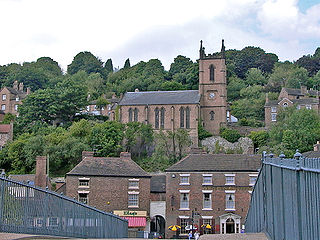
Ironbridge is a riverside village in the borough of Telford and Wrekin in Shropshire, England. Located on the bank of the River Severn, at the heart of the Ironbridge Gorge, it lies in the civil parish of The Gorge. Ironbridge developed beside, and takes its name from, The Iron Bridge, a 100-foot (30 m) cast iron bridge that was built in 1779.

The Severn Valley Railway is a standard gauge heritage railway in Shropshire and Worcestershire, England, named after the company that originally built the railway over which it now operates. The 16-mile (26 km) heritage line runs from Bridgnorth to Kidderminster, following the course of the River Severn along the Severn Valley for much of its route, and crossing the river on the historic Victoria Bridge.

The Ironbridge Gorge is a deep gorge, containing the River Severn in Shropshire, England. It was first formed by a glacial overflow from the long drained away Lake Lapworth, at the end of the last ice age. The deep exposure of the rocks cut through by the gorge exposed commercial deposits of coal, iron ore, limestone and fireclay, which enabled the rapid economic development of the area during the early Industrial Revolution.
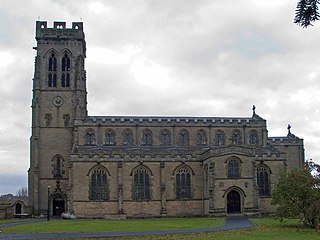
Broseley is a market town in Shropshire, England, with a population of 4,929 at the 2011 Census and an estimate of 5,022 in 2019. The River Severn flows to its north and east. The first iron bridge in the world was built in 1779 across the Severn, linking Broseley with Coalbrookdale and Madeley. This contributed to the early industrial development in the Ironbridge Gorge, which is now part of a World Heritage Site.

Coalport is a village in Shropshire, England. It is located on the River Severn in the Ironbridge Gorge, a mile downstream of Ironbridge. It lies predominantly on the north bank of the river; on the other side is Jackfield. It forms part of the civil parish of the Gorge and is the south-eastern corner of the borough of Telford and Wrekin.
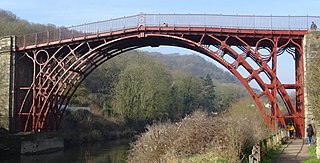
The Iron Bridge is a cast iron arch bridge that crosses the River Severn in Shropshire, England. Opened in 1781, it was the first major bridge in the world to be made of cast iron. Its success inspired the widespread use of cast iron as a structural material, and today the bridge is celebrated as a symbol of the Industrial Revolution.
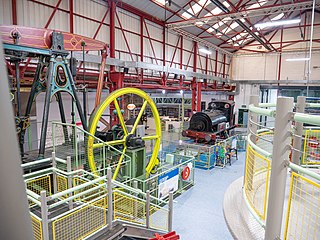
The Ironbridge Gorge Museum Trust is an industrial heritage organisation which runs ten museums and manages multiple historic sites within the Ironbridge Gorge World Heritage Site in Shropshire, England, widely considered as the birthplace of the Industrial Revolution.

Jackfield is a village in the Telford and Wrekin borough of Shropshire, England, lying on the south bank of River Severn in the Ironbridge Gorge, downstream from Ironbridge. Like many of the settlements in the area, it is notable for its place in the Industrial Revolution.
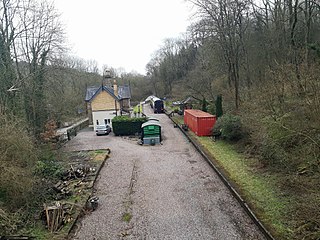
The GWR Coalport railway station, active 1862–1963, was originally built as a single through platform railway station on the Severn Valley Line serving the village of Coalport in Shropshire, England. By January 1896 an additional platform had been added, thus permitting up and down trains to pass along, with a third platform face behind the up platform to form an east-facing bay. By this time, the goods sidings to the east of the station had been expanded.

Ironbridge and Broseley railway station was a stop on the Severn Valley Railway Line; it served the towns of Broseley and village of Ironbridge in Shropshire, England.

Jackfield Halt was an unstaffed request stop on the Severn Valley line in Shropshire, England. Originally opened at Jackfield, west of Maw and Company's private sidings in 1934, it comprised a simple wooden platform and shelter.
The Wellington to Craven Arms Railway was formed by a group of railway companies that eventually joined the Great Western Railway family, and connected Wellington, Shropshire and Shifnal, with Coalbrookdale, Buildwas, Much Wenlock and a junction near Craven Arms. Its objectives were dominated by the iron, colliery and limestone industries around Coalbrookdale.
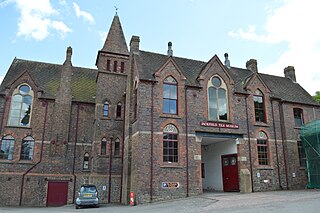
Jackfield Tile Museum is a museum which presents the history of the British decorative tile industry between 1840 and 1960, the period in which this factory and that of Maw & Co nearby played an important part in this industry. The museum lies in the village of Jackfield, near Broseley, on the south bank of the River Severn in the Ironbridge Gorge, in Shropshire, England. It is located within a World Heritage Site, the birthplace of the Industrial Revolution. It is one of the ten Ironbridge Gorge museums administered by the Ironbridge Gorge Museum Trust.
The Tuckies is a hamlet in the eastern part of Jackfield, lying on the south bank of the River Severn, in the Ironbridge Gorge, and opposite the village of Coalport. The purpose of this article is to capture its historical importance during the industrial revolution and provide links to the people and culture that once thrived here. The lower part of The Tuckies, in Ferry Road, is still badly affected by flooding and head-height water levels are clearly displayed in a doorway at The Boat Inn where the 1922 memorial footbridge crosses the River Severn to Coalport. The Severn Valley railway, operated by GWR, ran through The Tuckies and the original railway bridge, now forming part of the Severn Valley Way, still crosses the road there, at OS grid reference 693024.
The lost village of Werps was one of a group of small settlements which later became collectively known as Jackfield in the Broseley Parish in Shropshire. The Werps lay on the south side of the river Severn, opposite the Old Coalport China Works and records indicate either three or four public houses, although it is unclear as to whether any of their names are renames of the same building or whether re-built on the same site.

The Coalport branch line was a standard gauge London and North Western Railway branch line in Shropshire, England, which ran between Hadley Junction near Oakengates on the Stafford to Shrewsbury line and a terminus at Coalport East railway station on the north bank of the River Severn at Coalport.

Coalport Bridge is a cast iron arch bridge between Coalport and Preens Eddy in Shropshire, England.

The Museum of the Gorge, originally the Severn Warehouse, is one of the ten museums of the Ironbridge Gorge Museum Trust. It portrays the history of the Ironbridge Gorge and the surrounding area of Coalbrookdale, Shropshire, England.
Broseley is a market town and civil parish in Shropshire, England. It contains 37 listed buildings that are recorded in the National Heritage List for England. Of these, four are listed at Grade II*, the middle of the three grades, and the others are at Grade II, the lowest grade. The parish contains the town of Broseley, the village of Jackfield, and the surrounding countryside. It was in the 18th and early 19th centuries a centre for coal mining, then ironworking, but there are no significant survivors from this. In the later 19th century a tile making factory was established at Jackfield, and much of it survives as the Jackfield Tile Museum, many of its buildings being listed. In the town there is a former clay pipe factory which is listed. Otherwise, most of the listed buildings are houses, and the others include a farmhouse, a former hotel, public houses, a former butcher's shop, a former toll house, a church, and a war memorial.
{{cite book}}: CS1 maint: location missing publisher (link)